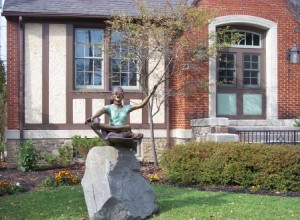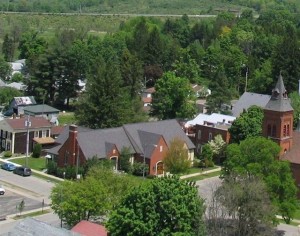History of the Library
A group of Cuba residents, in 1872, decided that the community needed a village library and began to organize it. Gathered together in the sessions room of the Baptist Church on the 21st day of September 1872, a small group of individuals proceeded to organize what was at first known as the Cuba Library Company. Edward D. Loveridge was chosen as Chairman of the meeting and Levi P. Blackford was chosen as Secretary. Shares of stock in the new venture were offered for sale at two dollars per share which brought about the grand sum of $331.00. The collection consisted of approximately 100 books when the library opened its doors.
Historians have recorded that a “sociable and supper” for the purpose of raising money to rent a library room was held and in 1873 the first space was rented at the Palmer Hall. The collection then consisted of about 700 volumes. By 1902 the membership was recorded as 800 patrons and the collections had grown from the original 100 volumes to 2,450. Later, the name was changed to Cuba Circulating Library Association and the Rev. J. C. Seeley was elected as librarian. A few years later a Miss Culver succeeded Rev. Seeley and then Mrs. Harriet Armstrong, assisted by Mrs. Alice Gillette, as librarians devoted much thought and time on the project. Space soon was apparently an issue and the organization left to move to the Eldridge Block on the corner of East Main and Genesee Street where a second floor room was rented for $25 per year. Here it remained until fire destroyed the block in 1921.
 It was 50 years after its founding that the library had one of its greatest moments. In 1922, the last will and testament of Mrs. Elisabeth Sheldon, a former librarian, bequeathed $30,000 to the Association for the construction and endowment of a new library. The will stated that the corporation name should be the “Cuba Circulating Library” and that a building was to be erected and that the institution must be forever a free library. There was some local controversy as to where the new library should be constructed but it was finally agreed that the property at the corner of East Main and Maple Streets should be acquired. The Kellogg Studio of photography occupied the upper floor, and Arnouts “Undertaking Establishment” was on the ground floor of the building which had occupied the site. A fine new, Tudor Style arts and crafts building was placed on the site and opened in 1924.
It was 50 years after its founding that the library had one of its greatest moments. In 1922, the last will and testament of Mrs. Elisabeth Sheldon, a former librarian, bequeathed $30,000 to the Association for the construction and endowment of a new library. The will stated that the corporation name should be the “Cuba Circulating Library” and that a building was to be erected and that the institution must be forever a free library. There was some local controversy as to where the new library should be constructed but it was finally agreed that the property at the corner of East Main and Maple Streets should be acquired. The Kellogg Studio of photography occupied the upper floor, and Arnouts “Undertaking Establishment” was on the ground floor of the building which had occupied the site. A fine new, Tudor Style arts and crafts building was placed on the site and opened in 1924.
Continued growth and demand for more services made it obvious again that more space was badly needed. In 1997 another bequest of $270,000 from Elisabeth Hixson Rossiter, who had served as assistant librarian and then librarian for many years, provided impetus for a major renovation and expansion project. A major fund raising drive was begun in 1999 and In January of 2000, the Cuba Circulating Library proudly reopened after the completion of a 10,000 square foot addition and total renovation of the original building. New meeting room facilities, a lift for handicap accessibility, new heating and air conditioning systems and a public computer area are among the improvements covered in the $800,000 project.
The institution that was started nearly 150 years ago has been nurtured and sustained by succeeding generations to become what it is today. The library provides services to more than 4,500 residents living within the greater Cuba area.
 In May 2012 the statue of “Girl Reading”, made by Cuba Elementary School students under the guidance of Dave Poulin, was unveiled in its permanent location on the Library front lawn.
In May 2012 the statue of “Girl Reading”, made by Cuba Elementary School students under the guidance of Dave Poulin, was unveiled in its permanent location on the Library front lawn.
On Saturday, July 17, 2021, Cuba Circulating Library sustained heavy damage from flooding of its lower floor caused by severe thunderstorms. While the damage to carpeting, walls and contents was significant, it could have been much worse had Library Director Tina Dalton not just happened to drop by the library that evening. The Cuba Fire Department responded to Dalton’s call for assistance and found that the library’s sump pump was not working. They got the pump working again and the water started receding in the older west side of the building, which houses a boiler room, the children’s story-time room and the book sale room. But water continued to stream in at the base of walls in the library’s newer wing, flooding the community room, a small kitchen and restrooms with several inches of water. The library lost many boxes of books that had been donated for the library’s used-book sale, as well as brand new children’s books that were to be used for prizes in our summer reading program. Carpeting and drywall in both the story-time and community rooms had to be replaced. Recovery costs included tearing out damaged carpeting and dry wall, installing a waterproofing system, installing sump pumps in the community room to service the newer wing, and installing new flooring and walls in the children’s room and community room. Thanks to donations received through community kindness and generosity, as well as funds received from the library’s insurance company, the library was able to cover the cost of the repairs. An open house was held on Tuesday, November 16, 2021 to thank the community for their support and offer patrons an opportunity to tour the newly renovated space.
In 2023, the library began a two-year renovation project in the children’s area. Phase one started in April and involved moving all of the books and other materials to the community room where a temporary children’s area was set up so that the public would still have limited access to those items. During Phase 1, the lighting was updated throughout the library, with new light fixtures installed in the children’s area, a wall with reading nooks, a play stage, a new video game station in the YA area, and a new water fountain with a bottle filler. Following the completion of Phase 1, the public was invited to an open house during Dairy Days. Phase 2 of the children’s area renovation is planned for fall 2024 with new carpets and paint throughout the main floor, a sculptural tree with seating, and a wall with an archway to mirror the one on the adult side of the main floor.

